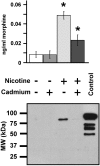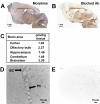Endogenous morphine in SH-SY5Y cells and the mouse cerebellum
- PMID: 18327293
- PMCID: PMC2265639
- DOI: 10.1371/journal.pone.0001641
Endogenous morphine in SH-SY5Y cells and the mouse cerebellum
Abstract
Background: Morphine, the principal active agent in opium, is not restricted to plants, but is also present in different animal tissues and cell types, including the mammalian brain. In fact, its biosynthetic pathway has been elucidated in a human neural cell line. These data suggest a role for morphine in brain physiology (e.g., neurotransmission), but this hypothesis remains a matter of debate. Recently, using the adrenal neuroendocrine chromaffin cell model, we have shown the presence of morphine-6-glucuronide (M6G) in secretory granules and their secretion products, leading us to propose that these endogenous alkaloids might represent new neuroendocrine factors. Here, we investigate the potential function of endogenous alkaloids in the central nervous system.
Methodology and principal findings: Microscopy, molecular biology, electrophysiology, and proteomic tools were applied to human neuroblastoma SH-SY5Y cells (i) to characterize morphine and M6G, and (ii) to demonstrate the presence of the UDP-glucuronyltransferase 2B7 enzyme, which is responsible for the formation of M6G from morphine. We show that morphine is secreted in response to nicotine stimulation via a Ca(2+)-dependent mechanism involving specific storage and release mechanisms. We also show that morphine and M6G at concentrations as low as 10(-10) M are able to evoke specific naloxone-reversible membrane currents, indicating possible autocrine/paracrine regulation in SH-SY5Y cells. Microscopy and proteomic approaches were employed to detect and quantify endogenous morphine in the mouse brain. Morphine is present in the hippocampus, cortex, olfactory bulb, and cerebellum at concentration ranging from 1.45 to 7.5 pmol/g. In the cerebellum, morphine immunoreactivity is localized to GABA basket cells and their termini, which form close contacts on Purkinje cell bodies.
Conclusions/significance: The presence of morphine in the brain and its localization in particular areas lead us to conclude that it has a specific function in neuromodulation and/or neurotransmission. Furthermore, its presence in cerebellar basket cell termini suggests that morphine has signaling functions in Purkinje cells that remain to be discovered.
Conflict of interest statement
Figures







Similar articles
-
Mapping of endogenous morphine-like compounds in the adult mouse brain: Evidence of their localization in astrocytes and GABAergic cells.J Comp Neurol. 2011 Aug 15;519(12):2390-416. doi: 10.1002/cne.22633. J Comp Neurol. 2011. PMID: 21456021
-
Identification of morphine-6-glucuronide in chromaffin cell secretory granules.J Biol Chem. 2006 Mar 24;281(12):8082-9. doi: 10.1074/jbc.M502298200. Epub 2006 Jan 24. J Biol Chem. 2006. PMID: 16434406
-
Simultaneous expression of guinea pig UDP-glucuronosyltransferase 2B21 and 2B22 in COS-7 cells enhances UDP-glucuronosyltransferase 2B21-catalyzed morphine-6-glucuronide formation.Mol Pharmacol. 2001 Nov;60(5):1040-8. doi: 10.1124/mol.60.5.1040. Mol Pharmacol. 2001. PMID: 11641432
-
Rethinking the opiate system? Morphine and morphine-6-glucuronide as new endocrine and neuroendocrine mediators.Med Sci Monit. 2006 Jun;12(6):SR25-7. Epub 2006 May 29. Med Sci Monit. 2006. PMID: 16733499 Review.
-
Morphine metabolites.Acta Anaesthesiol Scand. 1997 Jan;41(1 Pt 2):116-22. doi: 10.1111/j.1399-6576.1997.tb04625.x. Acta Anaesthesiol Scand. 1997. PMID: 9061094 Review.
Cited by
-
Morphine Binds Creatine Kinase B and Inhibits Its Activity.Front Cell Neurosci. 2018 Dec 3;12:464. doi: 10.3389/fncel.2018.00464. eCollection 2018. Front Cell Neurosci. 2018. PMID: 30559651 Free PMC article.
-
Mammalian cytochrome P450 enzymes catalyze the phenol-coupling step in endogenous morphine biosynthesis.J Biol Chem. 2009 Sep 4;284(36):24425-31. doi: 10.1074/jbc.M109.011320. Epub 2009 Jun 26. J Biol Chem. 2009. PMID: 19561069 Free PMC article.
-
Urinary excretion of morphine and biosynthetic precursors in mice.Proc Natl Acad Sci U S A. 2010 May 4;107(18):8147-52. doi: 10.1073/pnas.1003423107. Epub 2010 Apr 26. Proc Natl Acad Sci U S A. 2010. PMID: 20421505 Free PMC article.
-
Endogenous morphine levels are increased in sepsis: a partial implication of neutrophils.PLoS One. 2010 Jan 20;5(1):e8791. doi: 10.1371/journal.pone.0008791. PLoS One. 2010. PMID: 20098709 Free PMC article.
-
Abnormal nociception and opiate sensitivity of STOP null mice exhibiting elevated levels of the endogenous alkaloid morphine.Mol Pain. 2010 Dec 20;6:96. doi: 10.1186/1744-8069-6-96. Mol Pain. 2010. PMID: 21172011 Free PMC article.
References
-
- Stefano GB, Goumon Y, Casares F, Cadet P, Fricchione GL, et al. Endogenous morphine. Trends Neurosci. 2000;23:436–442. - PubMed
-
- Hazum E, Sabatka JJ, Chang KJ, Brent DA, Findlay JW, et al. Morphine in cow and human milk: could dietary morphine constitute a ligand for specific morphine (mu) receptors? Science. 1981;213:1010–1012. - PubMed
-
- Gintzler AR, Gershon MD, Spector S. A nonpeptide morphine-like compound: immunocytochemical localization in the mouse brain. Science. 1978;199:447–448. - PubMed
-
- Herbert RB, Venter H, Pos S. Do mammals make their own morphine? Nat Prod Rep. 2000;17:317–322. - PubMed
Publication types
MeSH terms
Substances
LinkOut - more resources
Full Text Sources
Miscellaneous

